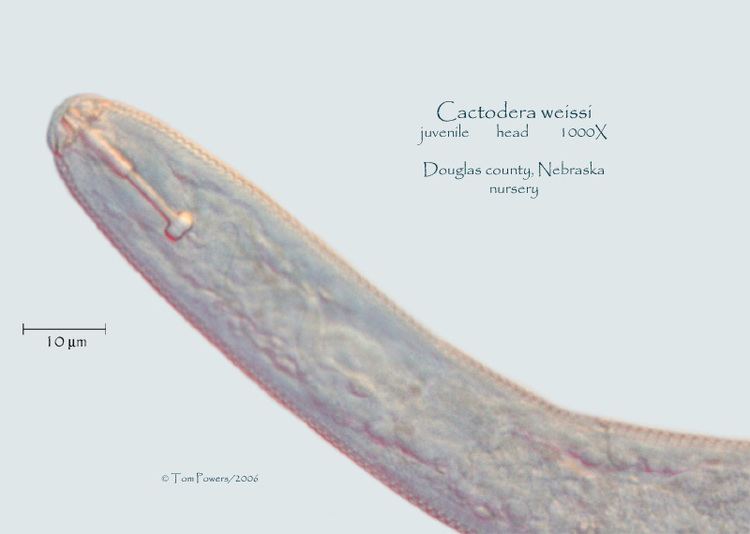Rank Species | Phylum Nematoda | |
 | ||
Similar Punctodera chalcoensis, Root gall nematode, Dolichodorus, Belonolaimus, Hirschmanniella oryzae | ||
Cactodera cacti, also known as the cactus cyst nematode or cactus cyst eelworm, is a plant pathogenic nematode. It is a pest of plants in the families Cactaceae, Apiaceae, and Euphorbiaceae.
Contents
History
Cactodera cacti was first discovered in 1932 affecting various species of cactus. It gained wider attention after it appeared in Belle Glade, Florida in the 1960s when it was discovered to have infected the roots of celery plants in greenhouses. It was believed that the parasite had spread due to the popular demand of cactus plants in gardens allowing the nematodes to easily spread to the other plants in the greenhouses. Recently there have been reports of C. cacti emerging in various greenhouses across parts of Northern China.
Distribution
In the United States the Cactus Cyst has been reported in Arkansas, California, Colorado, Florida, Georgia, Minnesota, and New York. It also ranges across parts of South America, Central America, Europe, and Asia.
As C. cacti feeds off the roots of plants they mainly target plant species with either fine root systems, like cactus and succulents, or taproot plants that store large amounts of nutrients within their roots, like carrots, parsley, and celery.
Life Cycle
C. cacti reproduces sexually with females laying their eggs in the roots of host plants. The eggs develop a tough protective pouch and form small round, yellow or brown tubercles on the roots of the plant, the "cyst" that gives the cactus cyst nematode its name. These eggs are extremely durable and allow the young to survive without food or water for up to 30 years. Once they do hatch the juvenile nematodes will remain in the roots of the plant feeding off them for nutrients until they go through their remaining three juvenile stages and turn into adults. Upon maturation the adult then will either re-infect the host plant or travel through the soil to find a new host and start the cycle all over again.
Symptoms and Signs
Plants that are infected with C. cacti often show signs of dying such as yellowing or dying leaves, wilting, stunted growth, and reduced flower production. Because the parasite attacks the roots of the plant it can also lead to root rot and allow for other parasites and various fungi to infest the plant as well.
Prevention
The best method to treat nematode infested crops is the rotation of crops by season, as the nematode will not survive without a suitable host. For potted plants or greenhouses it is recommended the soil be changed out or that the roots of the plant be culled before being re-potted into clean soil.
Impact
C. cacti is not significantly important in regards of an economic loss but can prove problematic in greenhouses, nurseries, and home gardens. In Mexico where cactus plants are often used for food production C. cacti infestations can cause problems for local food production.
